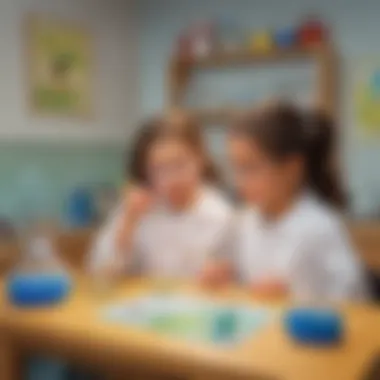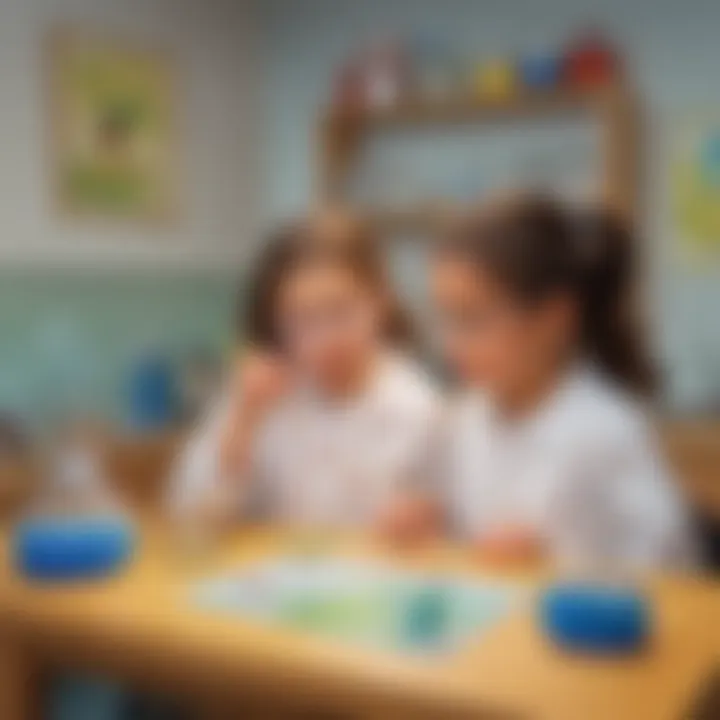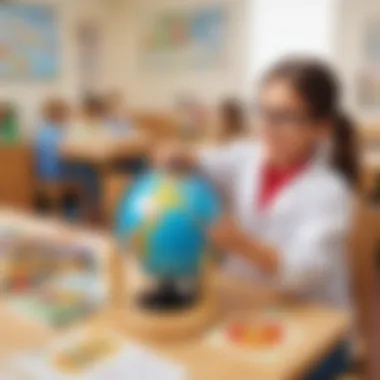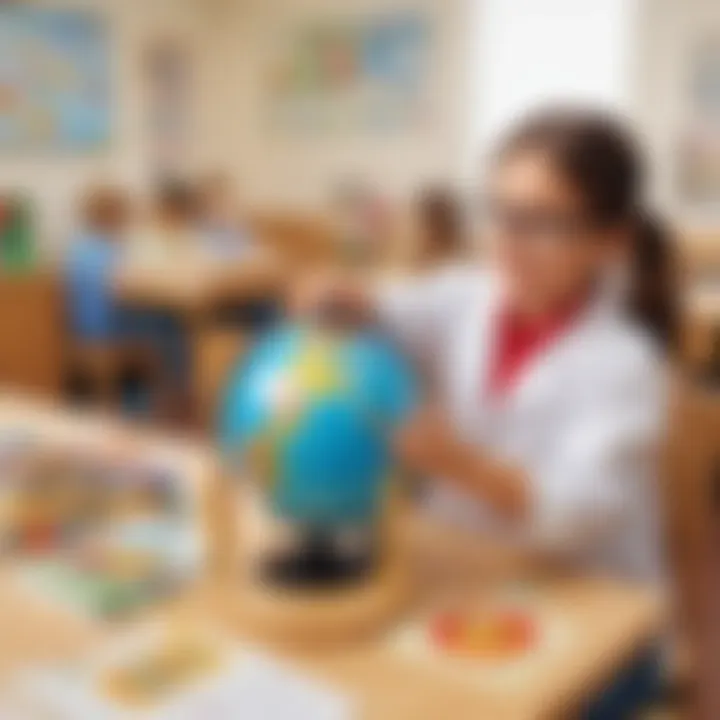Explore Free Science Lesson Plans for Kindergarten


Intro
In the world of education, igniting curiosity in young minds is paramount. Science offers a unique pathway for children to explore and understand their surroundings. Free kindergarten science lesson plans serve as invaluable resources for educators and parents. This guide aims to facilitate the early introduction of scientific concepts in a way that captivates young learners. By incorporating a variety of lesson plans and activities, this article addresses the significance of early science education and the beneficial outcomes of engaging children in the wonders of science.
Science Fun Facts
Introducing young children to science can be made more engaging by sharing fun and intriguing facts. Here are a few interesting trivia pieces that can naturally pique a child's interest in science:
- Did you know? The heart of a blue whale is as big as a small car and can weigh around 400 pounds.
- Interesting fact: Honey never spoils. Archaeologists have found pots of honey in ancient Egyptian tombs that are over 3000 years old and still edible.
- Quirky story: In 2007, a 13-year-old boy made headlines for starting a campaign to save the world’s bees. His action was driven by the alarming decline of bee populations, which play a crucial role in pollination.
- Thought-provoking question: Why do you think leaves change color in the fall? Sharing such questions can inspire children to think critically about their environment.
"Science is not only a disciple of reason but, also, one of romance and passion." - Stephen Hawking
Discover the Wonders of Science
Engaging children in various scientific concepts can be immensely rewarding. Here are some ways to explore the subject:
Exploring Various Scientific Concepts
Science encompasses many fascinating topics including biology, astronomy, and environmental science. Educators can create lessons around fireflies, the Solar System, or the water cycle.
Educational Videos and Animations
Videos can enhance learning. Websites like britannica.com offer educational material that children can easily digest. Simple animations illustrating concepts can hold their attention and promote understanding.
Interactive Learning Tools
Tactile experiences can make a huge difference. Using tools like interactive games or hands-on materials allows children to experience science rather than just learn it passively.
Real-Life Applications of Science
Showcasing how science applies to real-world scenarios is powerful. For example, cooking demonstrates chemical reactions. Discuss how baking bread involves yeast fermentation and how these scientific principles are present in everyday life.
Science Quiz Time
Quizzes offer an enjoyable way to reinforce learning. Here’s a brief overview:
Interactive Quizzes
Quiz competitions can spark excitement among children. Use platforms that allow game-like quizzes for increased engagement.
Multiple Choice Questions
An example question could be: "What planet is known as the Red Planet? A) Earth B) Mars C) Venus."
Brain Teasers and Puzzles
Simple science riddles can help develop critical thinking. For instance, ask: "What has roots as nobody sees, is taller than trees?"
Learning Through Gamification
Incorporating elements of games into learning can maintain interest. It creates an environment where children feel motivated to participate.
Science Experiment Showcase
Experiments bring the subject to life. Hands-on activities help children understand scientific concepts clearly.
Fun and Engaging Experiments
Simple experiments like growing beans in different environments or creating vinegar and baking soda volcanoes can invoke excitement.
Step-by-Step Instructions
Provide clear instructions for each experiment. For instance: mix vinegar and baking soda in a cup. Observe the reaction and discuss the science behind it.
Materials List
Ensure children understand what materials are needed for each experiment. This could include everyday items that are safe and easy to find.
Safety Tips and Precautions
Emphasize safety when conducting experiments. Always supervise young learners and explain the importance of careful handling of materials.
By navigating through this guide, educators and caregivers can foster a love for science in children. The goal is to make science accessible and enjoyable from an early age while laying groundwork for future learning.


Understanding the Importance of Science Education in Kindergarten
Science education in kindergarten serves as a gateway to understanding the natural world. It is crucial because young children possess an innate curiosity about their surroundings. By introducing them to scientific concepts early on, we can nurture that curiosity and provide a foundation for lifelong learning. This section explores the pivotal role of science education in early childhood, emphasizing its developmental benefits and its connection to critical thinking.
The Role of Science in Early Development
In early childhood, children engage their senses to explore their environment. The role of science in kindergarten is vital for cognitive and social development. Through scientific activities, children learn to ask questions, observe, and make predictions. This process stimulates their inquisitive nature, allowing them to start understanding complex ideas, like cause and effect.
Early exposure to science not only aids cognitive development but also supports emotional and social growth. Children often collaborate in science activities, fostering teamwork and communication skills. Moreover, these experiences enhance their problem-solving abilities, preparing them for challenges ahead in their academic journey. Educators must prioritize science in their curriculum to maximize these developmental advantages.
Building Curiosity and Critical Thinking Skills
Curiosity is a driving force in learning. In a science-rich environment, children dive into exploration and inquiry, which significantly boosts their curiosity. Engaging science lessons encourage them to ask "why" and "how," promoting deeper understanding.
Critical thinking also flourishes through hands-on science experiments. Children learn to analyze results, recognize patterns, and make decisions based on evidence. These skills extend beyond science; they are applicable in everyday problem-solving.
"Science is not only a subject but a way of thinking and inquiring about the world."
Core Principles of Early Science Learning
Early science education plays a crucial role in shaping the way young learners interact with the world. Understanding the core principles of early science learning can significantly impact how effectively educators and caregivers impart knowledge. These principles help to create a foundation where children can express curiosity and engage actively with scientific concepts.
In kindergarten, science opens the door to discovery. This stage is vital because children are inherently curious about their surroundings. By employing science as a learning tool, educators can nurture this curiosity and guide children towards critical thinking and problem-solving. Developing a scientific mindset at this young age fosters a deeper appreciation for learning and exploration throughout their lives.
Hands-On Experiences
Hands-on experiences are indispensable in early science learning. Engaging children with tangible materials allows them to experiment, observe, and draw conclusions from their interactions. For instance, activities such as planting seeds in soil enable children to witness biological growth firsthand. This not only solidifies their understanding of life cycles but also encourages them to ask questions about the process.
Such activities stimulate the senses and connect abstract concepts to real-world applications. When children can touch, see, and manipulate objects, their engagement increases. It opens opportunities for them to learn through trial and error. Furthermore, hands-on experiences promote teamwork when children collaborate on group projects, sharing insights and enhancing their social skills.
Collaboration and Social Interaction
Collaboration among peers adds a significant dimension to science learning in kindergarten. Young learners often benefit from sharing ideas and solving problems collectively. Group activities, such as building simple structures using blocks or conducting science experiments, encourage communication and cooperation. In these settings, children learn to express their thoughts and consider differing viewpoints.
Social interaction in learning environments also builds a sense of community. When children work together, they feel supported by their peers, fostering confidence in their ideas and contributions. This collective learning experience teaches them valuable lessons about negotiation, respect, and empathy, which are essential in both school and life.
Encouraging Exploration and Inquiry
Encouraging exploration and inquiry is fundamental in cultivating a love for science. A classroom environment that invites questions and allows for experimentation promotes an investigative mindset. For example, when children are given the freedom to ask "why" or "how," they tend to engage more deeply with the subject matter.
Providing opportunities for open-ended questions, such as exploring what makes a bird fly, leads to exciting discussions among children. Inquiry-based learning also enables them to develop critical thinking skills, as they learn how to formulate hypotheses and test them through observation.
In practice, teachers can adopt strategies such as observational walks, where children collect natural items and discuss them, or science-themed story time where stories inspire questions. This method encourages students to view themselves as active participants in their learning journey, not just passive receivers of information.
By adhering to these core principles of early science learning, educators can foster an environment that nurtures curiosity and builds essential skills that children will carry throughout their lives.
In summary, the principles of hands-on experiences, collaboration, and encouragement of exploration form the backbone of effective early science education. These strategies not only support learning about scientific concepts but also develop social and cognitive skills that extend beyond the classroom.
Elements of an Effective Lesson Plan
Creating a strong lesson plan is crucial for achieving success in kindergarten science instruction. Effective lesson plans not only guide educators but also enhance the learning experience for young children. They ensure that the lessons are structured, relevant, and engaging. Each component plays a vital role in how well children comprehend the material and remain interested. In this section, we will explore three essential elements: setting clear learning objectives, selecting appropriate materials, and creating an engaging learning environment.
Setting Clear Learning Objectives
Clear learning objectives serve as the foundation of any effective lesson plan. They outline what the educator aims to achieve during the lesson. Without specific objectives, lessons can become disorganized and unfocused, which can lead to confusion among students.
For kindergarten science, objectives should be age-appropriate, achievable, and measurable. For example, instead of a vague goal like "learn about plants," a clear objective would state, "students will identify three parts of a plant (roots, stems, leaves) and describe their functions."
This clarity helps educators stay on track and provides a roadmap to assess whether the children have grasped the material. When the objectives are clearly defined, it creates a purpose that motivates students to engage actively with the learning material.
Selecting Appropriate Materials
The selection of materials is another critical aspect of an effective lesson plan. The materials should support the learning objectives while being suitable for the age group. For kindergarteners, this often means using hands-on and interactive resources that spark interest.
Educators can utilize simple items like magnifying glasses, plant samples, or even multimedia resources such as videos and interactive apps. For example, using a magnifying glass can help children observe details that they might miss with the naked eye.
Additionally, it is important to consider the accessibility of materials. Educators should ensure that all necessary resources are readily available before the lesson to avoid interruptions. This preparation also means ensuring that the materials are safe and appropriate for young children.
Creating an Engaging Learning Environment
An engaging learning environment contributes significantly to the effectiveness of lesson plans. It should be a space where children feel safe, curious, and encouraged to explore.
Elements to consider include seating arrangements, decor, and interactive stations that align with the lesson theme. For example, if the lesson focuses on nature, incorporating plants and nature-themed decorations can enhance the experience.
Children’s collaboration is also essential in creating this atmosphere. Group activities encourage social interaction and deeper understanding of concepts. An engaging environment is one that fosters exploration, encourages questions, and allows for movement. Through active participation, students are more likely to retain the information presented in the lesson.
An effective lesson plan incorporates these essential elements, leading to a well-structured and meaningful learning experience for kindergarten children. By focusing on the clarity of objectives, careful selection of materials, and creating an engaging environment, educators can significantly enhance the quality of their science instruction.
Variety of Free Science Lesson Plans for Kindergarten
The inclusion of a diverse array of free science lesson plans is critical for kindergarten education. Young learners benefit from exposure to various scientific disciplines. This variety aids in keeping students engaged and curious about the world around them. Different themes, such as nature, physics, chemistry, and Earth sciences, provide opportunities for hands-on learning. This engagement is essential for fostering a lifelong interest in science.
Furthermore, presenting topics from various angles can help address different learning styles among children. Some may thrive in practical, hands-on experiences, while others may prefer observing or listening. Teachers and caregivers can adapt these plans according to individual needs, ensuring that no child feels left behind in their scientific exploration.
Including a variety of lesson plans also allows educators to integrate multiple subjects, promoting a holistic approach to learning. For instance, a lesson on plant biology can incorporate reading, writing, and even art. This interdisciplinary strategy enriches students' educational experience and helps them make connections across different areas of knowledge.
In this section, we explore some specific types of science activities that are both engaging and educational for kindergarteners.


Nature Exploration Activities
Nature exploration activities play a vital role in encouraging children's curiosity. They allow kids to observe the world first-hand. Activities can involve simple walks in a park or larger projects such as creating a garden in the classroom.
Some examples of nature activities include:
- Nature Scavenger Hunts: Children can search for different leaves, flowers, or insects. This activity promotes observation and categorization skills.
- Plant Growth Experiments: Kids can plant seeds and observe growth over time. This teaches patience and the cycle of life.
- Weather Observation Stations: Simply observing the weather helps children understand environmental changes.
These activities give children the chance to interact with their surroundings. This is key to developing a foundational understanding of science.
Simple Physics Experiments
Introducing basic physics to young learners can be exciting and accessible. Simple experiments can demonstrate fundamental principles such as motion, gravity, and balance.
Several engaging experiments could include:
- Balloon Rockets: By using string, straws, and balloons, children can explore concepts of propulsion and force.
- Balance Scales: Using a balance scale helps students understand weight and equilibrium. This can be easily done with household items.
- Magnets and Forces: Simple magnet activities encourage exploration of attraction and repulsion.
These experiments not only spark curiosity but also enhance problem-solving skills among kindergarteners.
Basic Chemistry Experiments
Chemistry can seem complex, but it can be broken down into fun, simple activities suitable for kindergarten. Basic chemistry experiments allow children to see changes in matter and do not require advanced equipment.
Consider these ideas:
- Baking Soda and Vinegar Reactions: This classic experiment illustrates chemical reactions and is safe and easy.
- Color Mixing: Using water and food dye, children can learn about colors and combinations.
- Homemade Slime: Making slime from glue and borax is a hands-on way to illustrate polymers.
Such activities provide practical experiences while teaching fundamental concepts about reactions, states of matter, and mixtures.
Earth Science Lessons
Earth science is crucial for young learners to understand their planet. Lessons on topics such as weather, rocks, and ecosystems can be both fun and informative.
Examples of engaging Earth science lessons may include:
- Rock Identification: By collecting different types of rocks, children learn about the Earth’s materials and how they form.
- Weather Stations: Creating simple instruments like rain gauges can help kids follow weather patterns over time.
- Ecosystem Exploration: A class trip to a nearby park can help them observe various ecosystems and how living organisms interact.
Earth science lessons instill a sense of stewardship towards the environment. This helps cultivate responsible future citizens.
Through diverse activities in science, educators can not only teach facts but also inspire wonder and inquiry among their young learners. The variety of free science lesson plans for kindergarten truly enriches the educational journey.
Integrating Technology into Science Education
Integrating technology into science education for kindergarten plays a significant role in enhancing learning experiences. It introduces young learners to concepts that they will encounter in their later studies while catering to their developmental needs. Technology can serve as a catalyst for inquiry-based learning, providing interactive and engaging ways for children to explore scientific principles.
There are specific benefits when technology is integrated into the curriculum. First, technology can support diverse learning styles. Children learn in various ways; some may respond better to visual tools, while others may prefer auditory elements. Technology provides a versatile approach that can accommodate these differences.
Moreover, technology helps in motivating students. Many children today are familiar with digital devices. Using educational tools familiar to them can heighten interest and involvement. Additionally, technology can enhance collaboration. Tools such as shared online platforms allow students to work together even if they are not physically in the same classroom. It brings young learners closer together, facilitating teamwork and social interaction.
In implementing technology in early science education, educators should also consider a few factors. First, they must ensure that the content is age-appropriate. It is crucial to choose resources that align with kindergarten learning objectives. Furthermore, time management plays a role. While technology is beneficial, it should not replace hands-on activities that encourage critical thinking and exploration. The balance is essential.
Using Educational Apps for Science Learning
Educational apps are a valuable tool in modern classrooms. Many apps focus on scientific concepts through playful activities and games. These apps make learning fun and interactive, allowing students to experiment with ideas in a low-pressure environment.
For young learners, quality educational apps like Kahoot! and Endless Alphabet can foster curiosity. These platforms can transform complex scientific concepts into simple, user-friendly formats. They usually feature bright graphics and engaging activities that capture kids' attention. Students can learn about the water cycle or animal habitats through games and challenges tailored for their age group.
Teachers should evaluate apps based on criteria such as educational content, usability, and suitability for targeted students. Parents can also be involved by encouraging children to use these apps at home, reinforcing what they learn in school.
Interactive Science Websites
Interactive science websites serve as another vital element in integrating technology into science education. Websites designed with early learners in mind can offer interactive lessons to explore science concepts at their own pace. National Geographic Kids and PBS Kids are two excellent examples that provide engaging content focused on science.
Typically, these platforms include videos, animations, and quizzes that can make complex subjects more accessible. Such interactive experiences can enhance learning by allowing children to see real-world applications of science.
Teachers should guide their students in using these resources effectively. This can include supervised access to websites during lessons, where children can explore while receiving guidance. Parents can also benefit from such resources to reinforce learning outside of classroom settings.
"Technology can enhance collaboration, allowing students to work together even if they are not in the same classroom."
Integrating technology into science education not only enriches the learning environment but also prepares children to engage with the world around them. As educators and parents harness the potential of educational apps and interactive websites, they will contribute to building a solid foundation for scientific inquiry and understanding in young learners.
Assessment and Evaluation Strategies
Assessment and evaluation strategies are critical components in kindergarten science education. They serve as tools for measuring children's understanding and interest in scientific concepts. Effective assessment helps educators tailor their teaching approaches to meet the specific needs of their learners. Evaluation strategies provide insights into what methods are successful and which ones may need adjustment.


Assessments in early science learning can take many forms. They not only gauge how well children grasp scientific ideas but also encourage ongoing conversations about science topics. This dialogue can further inspire curiosity and exploration, vital traits in young learners.
Observational Assessments
Observational assessments are a fundamental evaluation tool in kindergarten classrooms. These assessments involve educators watching and noting children's interactions during science activities. Unlike traditional tests, these observations offer real-time insights into how children engage with materials and concepts.
The benefits of observational assessments include:
- Holistic Understanding: Educators gain a comprehensive view of a child's abilities and interests.
- Real-World Application: Observations occur in natural settings, portraying how children use their knowledge in practical scenarios.
- Flexibility: These assessments can adapt to varied activities and learning styles, allowing for a better grasp of individual needs.
To utilize observational assessments effectively, teachers should maintain detailed notes that capture significant moments during activities. These notes can then inform future lesson plans and instructional decisions.
Feedback Mechanisms
Feedback mechanisms are another essential part of evaluation strategies. They establish a two-way communication channel between educators and students. In the context of science education, feedback helps children understand their progress and areas for improvement.
Effective feedback should be:
- Timely: Provides insights during or shortly after activities, facilitating immediate corrections or guidance.
- Constructive: Emphasizes strengths while highlighting areas needing attention, fostering a growth mindset.
- Specific: Focuses on distinct actions rather than vague statements, allowing children to pinpoint what to work on.
Feedback can take several forms, such as verbal comments, written notes, or peer discussions. Creating a safe environment for sharing feedback encourages children to embrace learning as a continuous process rather than a final destination.
Engaging Parents and Caregivers
Engaging parents and caregivers in the science education of children is essential. Their involvement greatly influences the learning experience and fosters a positive attitude towards learning. When parents participate, they validate the importance of science, creating a support system around their children's education. This connection between home and school can enhance children's motivation, encouraging them to explore and embrace scientific concepts.
Communicating the Value of Science Education
To effectively engage parents and caregivers, it is crucial to communicate the value of science education. This can be achieved through discussions, newsletters, or workshops that highlight how science encourages critical thinking and problem-solving skills. Importantly, science helps children understand the world. By conveying this understanding, educators can inspire families to appreciate the role of science. It is beneficial for parents to know that early exposure to scientific ideas can lead to a lifelong interest in the subject.
Some effective ways to communicate this value include:
- Informative Meetings: Organizing meetings where teachers explain the curriculum and the importance of each unit allows parents to understand the objectives and goals.
- Newsletters: Regularly send out newsletters that share facts about how science applies to everyday life. This keeps parents informed and engaged.
- Workshops: Host science workshops where parents can participate in simple experiments. This direct involvement shows them science can be fun and educational.
Involving Families in Science Activities
Involving families in science activities can significantly boost a child's interest in the subject. When families participate, children gain confidence. They also learn that science is not just something done in school, but a part of everyday life. Simple home experiments can create opportunities for interaction and learning.
Educators can suggest various family-friendly activities, such as:
- Nature Walks: Encourage families to take nature walks. They can collect samples like leaves or rocks. This can spur discussion about different species or earth materials.
- Home Experiments: Simple experiments, such as making a volcano with baking soda and vinegar, can be done at home. These activities are engaging and educational.
- Science Nights: Organize events at school where families come together to participate in science challenges or presentations. This builds a community around science education.
"Family involvement in science activities not only supports academic growth but also strengthens family bonds through shared learning experiences."
Resources for Science Lesson Plans
In the realm of early childhood education, particularly in the field of science, accessible and varied resources play a vital role. This section emphasizes the significance of well-chosen resources for science lesson plans tailored for kindergartners. Utilizing the right resources not only enhances the quality of instruction but also supports children’s natural curiosity. Parents and educators alike can greatly benefit from understanding what is available to make science engaging and effective for young learners.
Online Educational Platforms
Online educational platforms serve as treasure troves for educators creating science lesson plans. These platforms offer a wealth of resources, including videos, interactive activities, and lesson plan templates. For instance, websites such as PBS Kids and National Geographic Kids provide engaging content specifically designed for young audiences. These platforms not only support various learning styles but also make scientific concepts more accessible.
Benefits of using online educational platforms include:
- Diverse Content: Many platforms offer a range of topics, from biology to physics, suitable for different age groups.
- Interactive Features: Most platforms present information through interactive games and quizzes, which can make learning more enjoyable.
- Flexibility: Educators can access resources anytime, facilitating lesson planning at their convenience.
Incorporating resources from these sites can amplify the overall learning experience. Moreover, many online educational platforms offer printable materials that can be used directly in the classroom.
Printable Worksheets and Guides
Printable worksheets and guides are another essential resource for kindergarten science education. They provide structured activities that reinforce learning objectives in a tangible format. Worksheets can cover a variety of science topics, helping children practice new skills or concepts at their own pace.
Key considerations when using printable resources include:
- Alignment with Learning Goals: Ensure worksheets are tailored to the specific learning objectives of your lesson plans.
- Age Appropriateness: Select worksheets that match the developmental levels of kindergartners to maintain engagement and avoid frustration.
- Variety of Formats: Use a mix of worksheets, including coloring pages, matching exercises, and simple experiments. This diversity can cater to different interests and learning styles.
"Resources such as worksheets and online platforms significantly enhance the teaching experience and help instill a love for science in young children."
Finale
In the realm of early childhood education, a strong foundation in science is crucial. The integration of science into kindergarten curricula not only enhances students' understanding of the natural world but also nurtures their cognitive and social skills. Educational frameworks surrounding science lesson plans highlight the need for hands-on learning and exploration. In this article, we have examined various aspects that underpin effective kindergarten science education and identified ways to inspire curiosity.
Reflecting on the Importance of Science in Early Education
The significance of science in early education spans beyond mere academic knowledge. Engaging children in scientific concepts fosters their innate curiosity. When children observe and demonstrate their understanding of the world, they develop essential critical thinking skills. This lays the groundwork for analytical problem-solving and decision-making in later stages of life.
Science also encourages collaboration among peers. During investigations and group projects, children learn to work together, share ideas, and respect different opinions. This social interaction is vital for their holistic development. Moreover, it prepares them for future collaborative environments, whether in school or their future careers.
Furthermore, science lessons tailored to young learners often incorporate real-world applications. For instance, activities involving plants, animals, or even simple physical principles engage students in a tangible way. They connect theory to practice, making the learning process meaningful. Overall, early exposure to scientific principles builds a foundation that influences lifelong learning.
By reflecting on these elements, educators and caregivers can better appreciate the importance of integrating science in kindergarten. It becomes evident that fostering a child's scientific understanding is not just about teaching facts, but about igniting a passion for discovery and inquiry.







